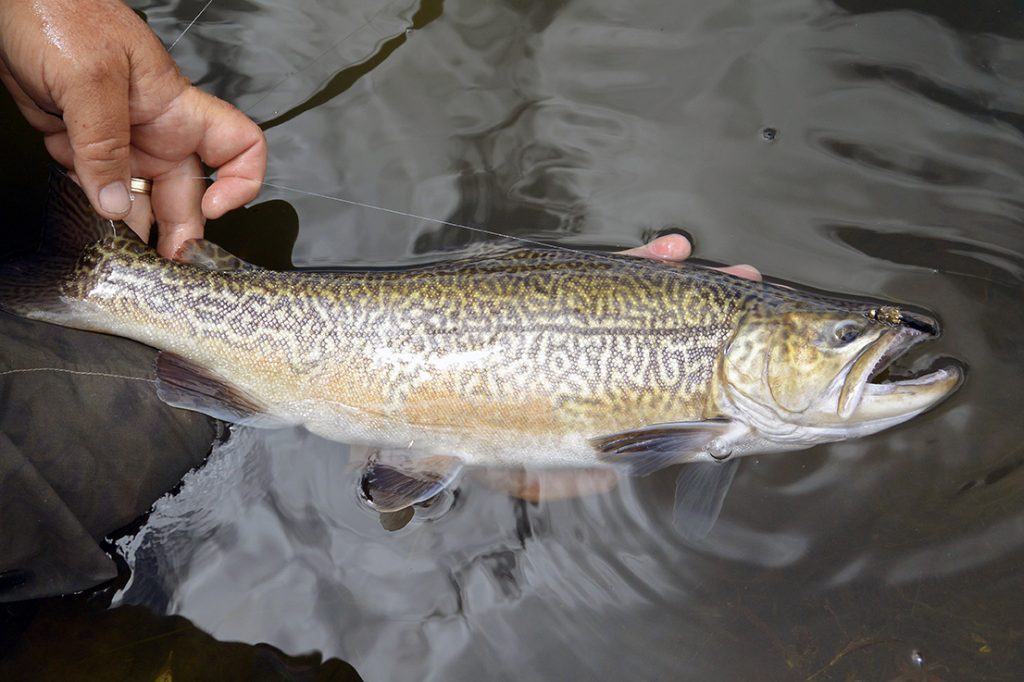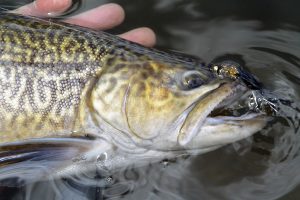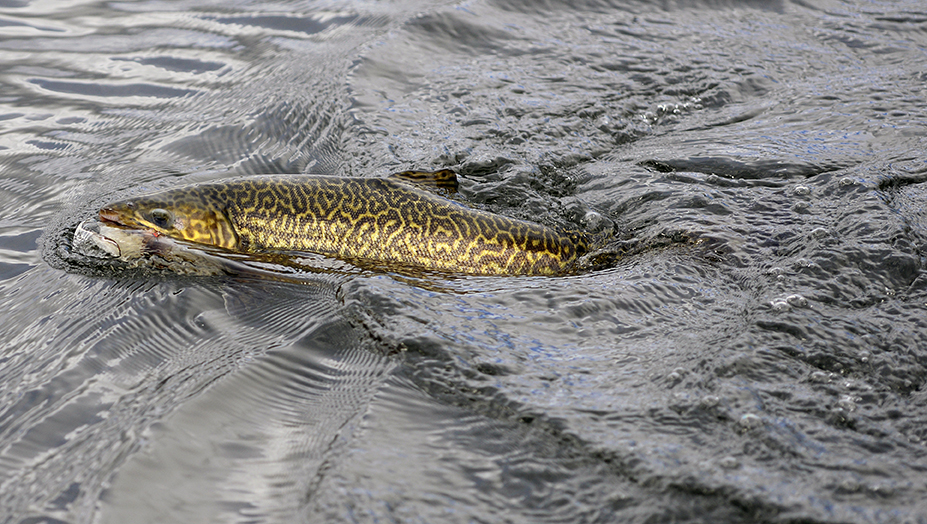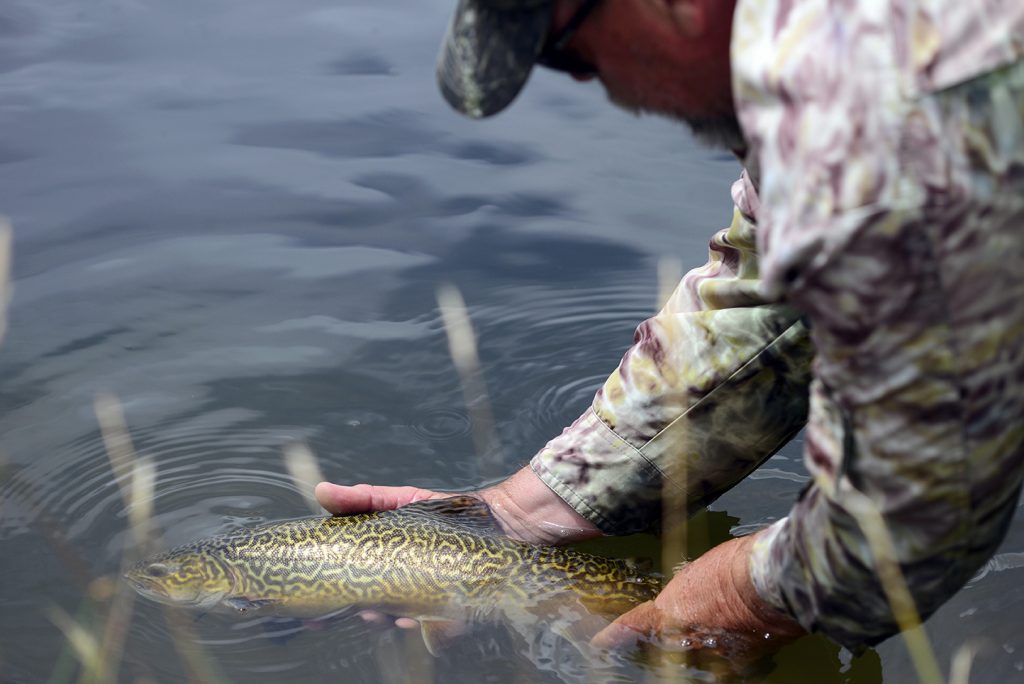Hunting Tasmanian Tigers
Most anglers love catching a new species, and that thrill is magnified when it’s a rare or unusual variety, such as the stunningly-marked, hard-fighting tiger trout.

The colours and patterning of the tiger trout are nothing short of stunning!
While I was in Tasmania last November shooting a couple of episodes of my new “A Fisherman’s Life” television series (exclusive to Fishflicks.tv), I was lucky enough to re-visit one of my favourite private trout fisheries: 28 Gates Luxury Farmstay, not too far out of Gretna, in the beautiful Derwent Valley.

The author with a chunky tiger trout on fly from 28 Gates Farmstay, near Gretna.
I completely understand that people have mixed views about private, pay-to-fish establishments of this sort. However, in my opinion, they have an important part to play in the bigger picture, right alongside completely “wild” fisheries, those supplemented by occasional re-stocking, and public put-and-take waters. Each has its own special charms and challenges.
Classy private fisheries such as 28 Gates and my other Tassie favourite — Currawong Lakes, south east of Campbell Town — closely resemble natural fisheries, but with limited access and controlled angling pressure. Their resident fish behave very much like “wild” trout and are rarely a push-over to catch. As a result, these establishments offer an experience that’s far removed from shooting fish in a barrel. Frankly, they can be as tricky as any other venue.

Flashy streamers and other wet flies seem to appeal most strongly to the predatory tiger trout.
The other attraction such private operations can potentially offer is access to fish that might not be widely available in public waters… such as tiger trout! I was very excited to hear that a small number of tigers had been stocked into one of the lovely lakes at 28 Gates, and I secretly hoped that I might cross paths with one of these fascinating critters. Those who’ve seen the second episode of my “A Fisherman’s Life” series on Fishflicks will know that this dream eventually became a reality on that November visit.
Since then I’ve been lucky enough to return to 28 Gates in high summer and catch a handful more Tassie tigers. Each one has only served to further cement my fascination with this unusual hybrid salmonid.

A hybrid between a brown and a brookie, tigers are certainly great-looking trout!
SO, WHAT’S A TIGER TROUT?
Let’s face it: tiger trout are completely man-made beasts. A hybrid or cross-breed between a brown trout from Europe and a brook trout (which is actually a char!) from North America, they shouldn’t be able to exist at all! Their parents don’t even belong to the same genus, and without human intervention, would never have come within three thousand kilometres of each other (the distance across the North Atlantic). But of course, we humans can’t help ourselves, and we’ve been moving wildlife around the globe willy nilly for centuries. These days it’s called “translocation”, but when the first Australians brought dingoes to our mainland 5,000 years ago, or the Romans introduced carp to western Europe during the Middle Ages, it was more a matter of pragmatic convenience. Ditto the successful introduction of trout to Tasmania way back in 1864.

The business end of a decent tiger trout.
Similarly, those European brown trout have been widely and thoroughly introduced to the Americas and other parts of the world and, to a lesser extent, brook char have been translocated to Europe and Australia.
With both of these fish spawning in autumn and early winter, it was only a matter of time until they encountered each other on the gravel redds. However, so different is their genetic make-up that “natural” inter-breeding of brookies and brown trout has only been recorded on rare occasions in the “wild”. Reports of such isolated anomalies do stretch back at least as far as 1944, mostly coming from places like Wisconsin and Michigan in the USA, where the two species now live side-by-side in numbers throughout some catchments. Belonging as they do to completely separate genera, and actually possessing different numbers of chromosomes (84 in brookies compared to 80 in browns), this accidental inter-breeding is a highly unusual occurrence at best, and the resulting fertilised eggs have a low survival rate; typically less than five per cent.

Starlo reckons tigers punch well above their weight.
However, by deliberately mixing the eggs and milt of brown and brook trout in a hatchery, and then heat shocking the fertilized eggs to create an extra set of chromosomes, these survival rates can be boosted to as much as 80 per cent. I believe that’s how Tasmania’s tigers are produced, and anyone who’s visited the wonderful Salmon Ponds hatchery facility at Plenty, near New Norfolk, will likely have marveled at the big, strikingly-patterned tiger trout on display in one of the ponds
HYBRID VIGOUR
Like many “inter-generic” hybrids (such as mules, which are produced by crossing horses and donkeys), tiger trout are normally regarded as being infertile and therefore unable to reproduce; either with each other or their parent species. There are exceptionally rare instances overseas of very low levels of fertility being observed in some tigers (mostly males), but as far as I know, this has never been reported here in Australia.

Although they rarely jump, tiger trout are strong, dogged battlers.
While infertility in hatchery-produced hybrids may seem at first glance to represent a serious defect, it can actually become a positive, especially when producing fish for stocking into put-and-take systems, where natural reproduction is either impossible or extremely unlikely. Infertile trout are also a handy option when stocking waterways potentially linked to areas with populations of sensitive native fauna. Should a decision be made at some future time to remove trout from these waterways, it’s simply a matter of not stocking any more and waiting for the existing population to die out, something that would generally occur in well under a decade.

Too good to catch just once!
Even more importantly for us as anglers, because tigers don’t devote physical and biological energy to the rigours of spawning, they tend to grow faster and maintain better condition throughout the year than their fertile cousins. This is the same phenomena displayed by triploided trout, such as the fat, fast-growing rainbows frequently stocked in many Tasmanian waters. Like tigers, these triploid rainbows are also infertile.

The vivid patterning of the tiger trout reminded the author of his beloved Murray cod.
But man-made creations such as tiger trout potentially exhibit an additional advantage not seen in triploid rainbows. I’m referring to a phenomenon known to science as heterosis or “hybrid vigour”. This simply means that some hybrids not only grow faster and attain larger sizes than their parent species, but also tend to be stronger and more active.
While hybrid vigour is best understood in plants, it also occurs on occasion in the animal kingdom. A classic example of this is the so-called “liger”: the result of cross-breeding a lion with a tiger. Ligers are the largest and strongest big cats on earth today, reaching a significantly greater length and weight than either a lion or a tiger. Tiger trout may well be their fishy equivalent.
TO CATCH A TIGER
So, what are tiger trout like to catch, and how are they best targeted? While I can still count my personal tiger tally on two hands, I’ve also been fortunate enough to speak to others who’ve caught them, and I’ve done quite a lot of research in putting this article together.
One of the more common traits mentioned by most authors when discussing tiger trout is their highly piscivorous nature. In other words, they prefer to feed on small fish rather than invertebrates and terrestrial organisms. This certainly tallies closely with my personal experience. All my tiger encounters to date have occurred while stripping wet flies such as Woolly Buggers, Woolly Worms and various streamers, even on days when brown and rainbow trout living in the same body of water were rising freely to insects. This is certainly not to say that tigers can’t be caught on dry flies, but it does seem that they’re much easier to target on wets or lures.
It’s also worth remembering that the tiger’s temperature tolerances lean more towards those of their brook char parents than the hardier and more adaptable brownie. Like brookies, tigers prefer cold, well-oxygenated water. As a result, they can tend to become sulky and lethargic in hot weather and will seek out deeper, cooler lies, often in close proximity to weed beds and other cover. When this happens, it pays to get your lures and flies down as deep as possible.

Jo hooked up at 28 Gates.
Once hooked, I’ve found tigers to be surprisingly strong for their size, but not great jumpers. They will thrash wildly on the surface at times, but rarely (in my experience) do they jump cleanly clear of the water. Overall, their fight can best be described as a mix between that of a brown and a rainbow, minus the aerobatics, but with lots of angry head shakes and dogged lunges back towards the depths where they were hooked. In almost every case, I’ve been surprised at just how hard they pull for their weight, sometimes taking twice as long to subdue as a brown or rainbow of a similar size. I’ve only caught them to about 1.5 kg so far. I can only imagine how hard a really big one might pull!
TRACKING TIGERS
Tasmanian anglers and visitors to the state hoping to add a tiger to their trout tally currently have rather limited options to pursue.
As mentioned, tiger trout are stocked in several of the state’s private fisheries, including 28 Gates and Twin Lakes. According to an IFS fact sheet on the service’s website, relatively small numbers of tigers have also been sporadically released into a handful of public waters across the state. Historically, these have included Pet Dam (near Burnie), Lake Dulverton (at Oatlands) and Pawleena Lagoon. There were even isolated reports a decade or so back of a few stray tigers being caught from Great Lake, although the exact origin of those specimens remains unclear.
More recently, a reasonable number of adult tiger trout escaped from a north eastern fish farm facility during the 2016 floods, ultimately ending up in the St Patricks River, with a few possibly finding their way as far afield as the North Esk. Those anglers lucky enough to tap into this unplanned bonanza reportedly hooked tigers to 4 kg and more in weight the following season, and spoke very highly of their fighting prowess, especially in faster water!

There are some big rainbow trout at 28 Gates, too!
I can’t help but wonder if the deliberate stocking of a few more tiger trout into a couple of Tasmania’s put-and-take fisheries might not help to create a wave of intense interest amongst anglers: both locals and visitors. Certainly, hatchery productivity for the species is relatively low compared to browns and rainbows, resulting in higher costs per fingerling or adult. But isn’t it possible that the novelty value of a couple of waters containing reasonable numbers of trophy tigers might not repay that investment many times over in terms of the angler effort (and expenditure) generated? In my opinion, it’s certainly something worth thinking about.
Steve ‘Starlo’ Starling is one of Australia’s best-known fishing writers and presenters. You can read his latest blogs here at www.starlofishing.com and watch his new “A Fisherman’s Life” series exclusively on Fishflicks.tv, as well as following his Starlofishing pages on Facebook and #starlofishing account on Instagram.


Thanks for this article, Steve. It answers, more than adequately, a few questions I had following your earlier writings on tiger trout.
[* Shield plugin marked this comment as “0”. Reason: Human SPAM filter found “, .” in “comment_content” *]
Hello Steve,
Very interested in your blog about Tiger trout, there’s some interest in this species in our club (Lake Purrumbete AC), which started trial stockings of Brook trout in 2016. Only time will tell whether there’s enough support to also trial Tiger trout.
cheers, … Rob